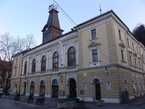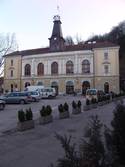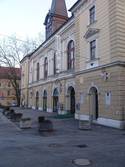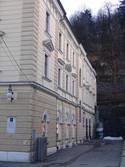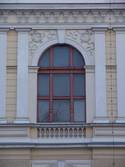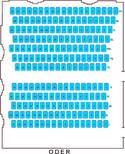Ljubljana Puppet Theatre and Šentjakob Theatre
alias Mestni dom (Town Home)Krekov trg 2, SI-1000 Ljubljana | |
| show on the map | http://www.lgl.si |
Important events
People
History
The Puppet Theatre in Ljubljana and Šentjakob Theatre share the Mestni dom building, which was originally not dedicated to theatrical activities. The building first appeared on the location of the filled-in defence moat in front of the former Franciscan town gate (also known as the Monastery gate). The moat was filled in the early 19th century, whilst in 1816 the municipality had the location levelled and a fairground was constructed on the newly acquired square. It was originally named Sejemski trg (Fair Square); between 1876 and 1918 it carried the name of the Emperor Joseph; between 1918 and 1919 that of King Peter; and since 1919 it has been known as Krekov trg (Krek Square). In the mid-19th century the appearance of the square began to alter as the old buildings were extended upwards and new buildings were added. In 1919 an icehouse was built on the corner next to the slope of the castle hill, which was used until 1928. The square experienced its most significant change when the Mestni dom building was constructed, closing off the southern side of the square. Formerly, there had been wooden huts here in which washerwomen kept their linen. In 1897, upon the initiative of Mayor Ivan Hribar, as part of the ambitious town renovations after the 1895 earthquake, the Ljubljana town administration decided to build on this location an impressive Fire Station with a hall for public events on the upper floor. Soon, a public call for plans was published and the selection committee appointed. A number of architects from Prague, Paris, Vienna and Hamburg applied. The first award was given to two brothers, the architects Mauvrinij and Carol Hinträger, who then by the spring of 1898 drew up the master plan. As the award winners’ price for the production of implementation plans was not acceptable to the investor, the commission was instead given to the Ljubljana town architect Ciril Metod Koch (1867-1925), who slightly altered the plans. The building work commenced on 18 July 1898. When the washerwomen’s huts were removed, a crack appeared in the slope and soil began to slide down the hill, covering a part of the new foundations. The problem was resolved by building a tall protective stone wall, which made the project much more expensive. The construction was completed by 30 September 1899, but the official opening was a few days earlier, on the 8th. Most of the construction work was carried out by the firm Faleschini & Schuppler.
Most of the space in the new building was given to the voluntary fire-fighting society; on the ground floor, there was space for the fire trucks, whilst on the upper floors there were living premises for fire-fighters and policemen. This is why there were in the main façade five large, semi-circular gate openings. The building also housed rescue services, a police guardhouse and living quarters, and the administration of the town water and electricity supply services. This is why the building was named Mestni dom (Town Home). A large auditorium on the first floor was intended for various societies. Election gatherings, parties, assemblies, exhibitions and meetings of conscription commissions took place there. The building had an approximately square ground floor plan and had an imposing frontage. The exterior was designed in the dominant Neo-Renaissance style and emphasised with a roof tower positioned on the central axis of the main façade. When designing the interior the architects, understandably, focused on the central hall, which is comparable to that of the Maribor Narodni dom (National Home), built at roughly the same time, and they gave it a Neo-Classical structure with pilasters. From the very beginning, the hall was also intended for theatre performances. The building, especially its interior, was later altered a number of times, whilst the exterior lost two slender pyramid-like obelisks next to the roof tower, which at first served as a fire observation point. In spite of various alterations, the basic characteristics of the building from the late 19th century have not changed to this day.
The Mestni dom began to take on the role of a theatre in 1932. It was then that the Šentjakob Theatre group began to use the auditorium on the first floor. This theatre is considered one of the oldest permanent repertoire amateur theatres in the world. It was established in 1920 in the Ljubljana suburb of Šentjakob by the amateur society for the Šentjakob district and, before moving to Mestni dom, occupied premises in the building belonging to the orphanage in the street known as Florjanska ulica. After the move, the theatre flourished, but this ended with the outbreak of the Second World War in Yugoslavia in 1941. The Italian occupying forces removed the stage in Mestni dom and the auditorium was used for their fire-fighting services. Šentjakob Theatre regained the hall in 1946; the members built a new stage by themselves. During the 1960s, after the professional fire brigade had moved out, more of the premises on the first floor were allocated to the theatre and an exit from the eastern side of the building was added. The theatre developed in the form of a cultural society that now consists of the amateur actors’ ensemble, the professional administration and technical services and professional theatre staff. The society’s voluntary amateur activities include approximately 150 members. The programme leans towards lighter content, mainly comedies and performances for children and young people. The hall in the Mestni dom has 207 seats in 12 rows.
Between 1983 and 1984, the building was thoroughly renovated and has since been dedicated fully to theatrical activities. The ground floor, which was after 1970, when the fire brigade moved out, used by a greengrocer’s, once more changed occupants when the Ljubljana Puppet Theatre moved in. At the same time, the Šentjakob Theatre on the first floor acquired a new stage, improved technical facilities, more backstage space, new administrative offices and on the second floor space for an archive. Around 1987, the attic space was utilised for the requirements of the Puppet Theatre so that there is now a puppet museum, the first of its kind in Slovenia. In connection with this in 1987 a clock was put in the roof tower, which incorporates puppets of the fictional hero Martin Krpan and his mare, and which chimes every three hours. The beginnings of the Puppet Theatre’s activities in Mestni dom go back as far as the 1920s: between 1920 and 1924 the Slovene Marionette Theatre, the first (semi-) professional puppet theatre in Slovenia was housed there, led by the pioneer of Slovene puppeteering Milan Klemenčič. In 1948, the Town Puppet Theatre was founded in premises on the square Levstikov trg. The theatre initially relied on various traditions that have marked Slovene puppeteering from its beginnings in the 1920s to the end of the Second World War. After 1983, three stages were created for the requirements of the Puppet Theatre. On the ground floor a large stage was put where there had formerly been garages for fire engines. The ground plan of this area measures 10 x 12 metres and facilitates the staging of technically more demanding puppet and acted performances. The modern auditorium can receive an audience of up to 253 people. Next to the large stage, there is also a small stage with a ground floor plan of 5 x 5 metres. The equipment here facilitates the changing of the depth of the stage and thus the number of seats, depending on the character of the performance. It can seat up to 100 people. After the renovations of the attic around 2000, when a part of the building acquired a new glass roof, a "Stage under the Stars" was added, measuring 30 x 8 metres, with room for 300 people, which is used for various concerts, meetings and presentations.
Sources and literature
Anja Garbajs, Šentjakobsko gledališče danes, Gledališki list Šentjakobskega gledališča (Slavnostni dnevi Šentjakobskega gledališča, Posebna številka gledališkega lista), 80. sezona, št. 3, 2000/2001, pp. 12–16
Anja Garbajs, Šentjakobsko gledališče kot del ljubljanskega družbenega življenja, diplomsko delo na Fakulteti za družbene vede Univerze v Ljubljani, Ljubljana 2002
Ančka Grgurevič-Mirko Mahnič-Miran Petrovčič, Jubilejni zbornik Šentjakobskega gledališča. 1920-1950, Ljubljana 1950
Darinka Kladnik, Ljubljanske metamorfoze, Ljubljana 1991, pp. 68–69, 94–95
Milko Kos, Srednjeveška Ljubljana, Ljubljana 1955
Ida Marinčič-France Kvaternik (ur.), Jubilejni zbornik Šentjakobskega gledališča. 1921–1981, Ljubljana 1981
Vanja Mehle, Kratek oris zgodovine našega gledališča, Gledališki list Šentjakobskega gledališča (Slavnostni dnevi Šentjakobskega gledališča, Posebna številka gledališkega lista), 80. sezona, št. 1, 2000/2001, pp. 8–11
Vanja Mehle, Diletantje in amaterji ali kaj so včasih drugi menili o nas. Drobci iz nastajajoče diplomske naloge Vanje Mehle, Gledališki list Šentjakobskega gledališča (Slavnostni dnevi Šentjakobskega gledališča, Posebna številka gledališkega lista), 80. sezona, št. 4, 2000/2001, pp. 12–14
Vanja Mehle, 80 let Šentjakobskega gledališča, diplomsko delo na Oddelku za zgodovino Filozofske fakultete Univerze v Ljubljani, Ljubljana 2001
Breda Mihelič, Vodnik po Ljubljani, Ljubljana 1989, pp. 47–48
Peter Ovsec-Anica Šinkovec-Tatjana Rebolj-Peter Teichmeister (ur.), Teater je teater. Zbornik ob 70-letnici Šentjakobskega gledališča, Ljubljana 1991
Peter Ovsec, Šentjakobsko gledališče Ljubljana. Leta ljubezni in dela. 1921–1996, Ljubljana 1996
Peter Ovsec, Šentjakobsko gledališče, Glasilo mestne občine Ljubljana, Ljubljana september 2000
Miran Petrovčič (ur.), Jubilejni zbornik Šentjakobskega gledališča. 1920–1961, Ljubljana 1961
Slavko Pezdir, Šentjakob naj gre v Moste?, Delo, 27. 6. 2008, p. 25
Ivan Stopar, Sprehodi po stari Ljubljani, Ljubljana 1992, pp. 178–179
Šentjakobski gledališki oder 1921–1936, Ljubljana 1936
Šentjakobsko gledališče. 1921–1971. Jubilejni zbornik, Ljubljana 1971
Tjaša Valentinčič, Identiteta Šentjakobskega gledališča. Šentjakobski gledališče v očeh članov, sodelavcev, občinstva in javnosti, diplomsko delo na Fakulteti za družbene vede Univerze v Ljubljani, Ljubljana 2008
Walter Lukan (ur.), Pozdrav iz Ljubljane. Mesto na starih razglednicah, Ljubljana 1986, p. 150
Jos. Wester, Momenti v razvoju Ljubljane od 1787–1827, Kronika slovenskih mest, št. 1, 1934, pp. 23–27
Author: Igor Sapač
Igor Sapač:
The Miners’ Theatre in Idrija, The Tartini Theatre, Ptuj Town Theatre, Slovene People's Theatre Celje, The Slovene National Theatre Drama, Ljubljana, The Koper Theatre, The Slovene National Theatre Maribor, The Slovene National Theatre Opera and Ballet Ljubljana, The Prešeren Theatre, Kranj, Maribor Puppet Theatre, Ljubljana Puppet Theatre and Šentjakob Theatre, The Estates Theatre in LjubljanaTranslator: Maja Visenjak Limon
Maja Visenjak Limon:
The Miners’ Theatre in Idrija, The Tartini Theatre, Ptuj Town Theatre, Slovene People's Theatre Celje, The Slovene National Theatre Drama, Ljubljana, The Koper Theatre, The Slovene National Theatre Maribor, The Slovene National Theatre Opera and Ballet Ljubljana, The Prešeren Theatre, Kranj, Maribor Puppet Theatre, The Slovene National Theatre Nova Gorica, Ljubljana Puppet Theatre and Šentjakob Theatre, The Estates Theatre in Ljubljana, Trieste Permanent Slovene Theatre, The Old Power Station, The Mladinsko TheatreAdditional information
No information has yet been entered
Add information


